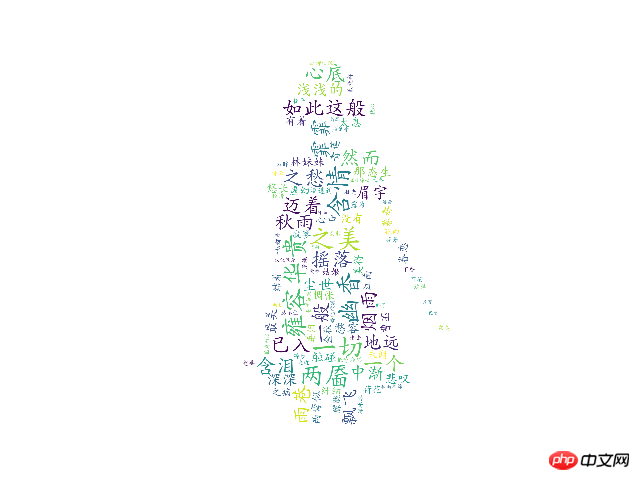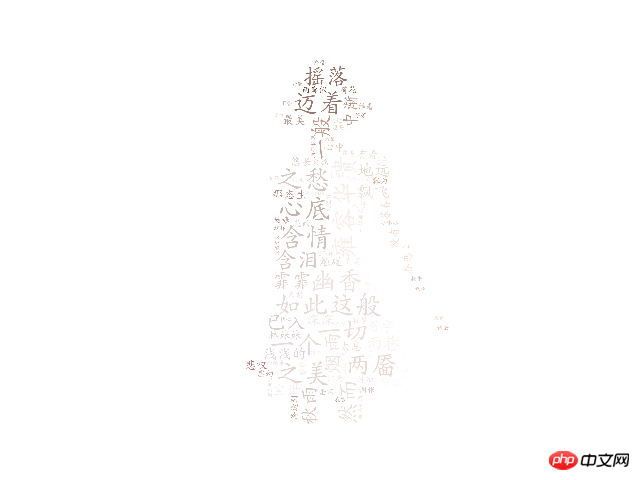 Backend Development
Backend Development
 Python Tutorial
Python Tutorial
 How to use python to implement sample code sharing of personalized word clouds
How to use python to implement sample code sharing of personalized word clouds
How to use python to implement sample code sharing of personalized word clouds
I recently saw a visual word cloud, and there are many such tools on the Internet, but they are not perfect. Some do not support Chinese, some Chinese word frequency statistics are inexplicable, some do not support custom shapes, and all of them are The color cannot be customized, so I searched online and decided to use python to draw the word cloud
First upload the picture

Word cloud diagram
Need template
pip install jieba pip install wordcloud
Also needInstallationI don’t know much about the other two things written by Baidu
pip install scipy pip install matplotlib
Because using the Ubuntu system is not as troublesome as Windows, and there are not so many errors
Do you feel excited when you see so many people making their own word clouds? If you are excited, go immediately Doing it, impulse is the first creativity.
jieba is a very easy to use Chinese word segmentation template
jeiba Chinese document
As for wordcloud, there is no Chinese document but we If you know how to guess, if your English is not good, we can guess. Check the source code to guess.
Contribute all my code first
#-*-coding:utf-8—-*-
import jieba.analyse
from wordcloud import WordCloud,ImageColorGenerator
from scipy.misc import imread
import matplotlib.pyplot as plt
class wc:
def init(self,txt_file,img_file,font_file):
self.f = open(txt_file,'r')
self.txt = self.f.read()
self.f.close()
self.tags = jieba.analyse.extract_tags(self.txt,topK=100)
#topK说白了就是返回几个关键词
self.text = ' '.join(self.tags) #把分词链接起来,加空格因为英文靠空格分词
self.img = imread(img_file)
self.wc = WordCloud(font_path=font_file,background_color='white',max_words=100,mask=self.img,max_font_size=80)
###直接在这里进行猜###
#font_path指的是字体文件路径,因为wordcloud自带的字体不支持中文所以我们要指定一个字体文件,否者输出的图片全是框框
#background_color 默认是黑色 我设置成白色
#max_words最大显示的词数
#mask 背景图片
#max_font_size 最大字体字号
self.word_cloud = self.wc.generate(self.text)
def show_wc(self):
#img_color = ImageColorGenerator(self.img)
plt.imshow(self.word_cloud)
#可以通过 plt.imshow(self.wc.recolor(color_func=img_color))使图片颜色跟字体颜色一样
plt.axis("off")
plt.show()
if name=='main':
mywc = wc('sanwen.txt','out.png','font.ttc')
mywc.show_wc()
Use wc.recolor(color_func=img_color)
The above is the detailed content of How to use python to implement sample code sharing of personalized word clouds. For more information, please follow other related articles on the PHP Chinese website!

Hot AI Tools

Undresser.AI Undress
AI-powered app for creating realistic nude photos

AI Clothes Remover
Online AI tool for removing clothes from photos.

Undress AI Tool
Undress images for free

Clothoff.io
AI clothes remover

AI Hentai Generator
Generate AI Hentai for free.

Hot Article

Hot Tools

Notepad++7.3.1
Easy-to-use and free code editor

SublimeText3 Chinese version
Chinese version, very easy to use

Zend Studio 13.0.1
Powerful PHP integrated development environment

Dreamweaver CS6
Visual web development tools

SublimeText3 Mac version
God-level code editing software (SublimeText3)

Hot Topics
 1384
1384
 52
52
 PHP and Python: Code Examples and Comparison
Apr 15, 2025 am 12:07 AM
PHP and Python: Code Examples and Comparison
Apr 15, 2025 am 12:07 AM
PHP and Python have their own advantages and disadvantages, and the choice depends on project needs and personal preferences. 1.PHP is suitable for rapid development and maintenance of large-scale web applications. 2. Python dominates the field of data science and machine learning.
 Python vs. JavaScript: Community, Libraries, and Resources
Apr 15, 2025 am 12:16 AM
Python vs. JavaScript: Community, Libraries, and Resources
Apr 15, 2025 am 12:16 AM
Python and JavaScript have their own advantages and disadvantages in terms of community, libraries and resources. 1) The Python community is friendly and suitable for beginners, but the front-end development resources are not as rich as JavaScript. 2) Python is powerful in data science and machine learning libraries, while JavaScript is better in front-end development libraries and frameworks. 3) Both have rich learning resources, but Python is suitable for starting with official documents, while JavaScript is better with MDNWebDocs. The choice should be based on project needs and personal interests.
 How is the GPU support for PyTorch on CentOS
Apr 14, 2025 pm 06:48 PM
How is the GPU support for PyTorch on CentOS
Apr 14, 2025 pm 06:48 PM
Enable PyTorch GPU acceleration on CentOS system requires the installation of CUDA, cuDNN and GPU versions of PyTorch. The following steps will guide you through the process: CUDA and cuDNN installation determine CUDA version compatibility: Use the nvidia-smi command to view the CUDA version supported by your NVIDIA graphics card. For example, your MX450 graphics card may support CUDA11.1 or higher. Download and install CUDAToolkit: Visit the official website of NVIDIACUDAToolkit and download and install the corresponding version according to the highest CUDA version supported by your graphics card. Install cuDNN library:
 Detailed explanation of docker principle
Apr 14, 2025 pm 11:57 PM
Detailed explanation of docker principle
Apr 14, 2025 pm 11:57 PM
Docker uses Linux kernel features to provide an efficient and isolated application running environment. Its working principle is as follows: 1. The mirror is used as a read-only template, which contains everything you need to run the application; 2. The Union File System (UnionFS) stacks multiple file systems, only storing the differences, saving space and speeding up; 3. The daemon manages the mirrors and containers, and the client uses them for interaction; 4. Namespaces and cgroups implement container isolation and resource limitations; 5. Multiple network modes support container interconnection. Only by understanding these core concepts can you better utilize Docker.
 MiniOpen Centos compatibility
Apr 14, 2025 pm 05:45 PM
MiniOpen Centos compatibility
Apr 14, 2025 pm 05:45 PM
MinIO Object Storage: High-performance deployment under CentOS system MinIO is a high-performance, distributed object storage system developed based on the Go language, compatible with AmazonS3. It supports a variety of client languages, including Java, Python, JavaScript, and Go. This article will briefly introduce the installation and compatibility of MinIO on CentOS systems. CentOS version compatibility MinIO has been verified on multiple CentOS versions, including but not limited to: CentOS7.9: Provides a complete installation guide covering cluster configuration, environment preparation, configuration file settings, disk partitioning, and MinI
 How to operate distributed training of PyTorch on CentOS
Apr 14, 2025 pm 06:36 PM
How to operate distributed training of PyTorch on CentOS
Apr 14, 2025 pm 06:36 PM
PyTorch distributed training on CentOS system requires the following steps: PyTorch installation: The premise is that Python and pip are installed in CentOS system. Depending on your CUDA version, get the appropriate installation command from the PyTorch official website. For CPU-only training, you can use the following command: pipinstalltorchtorchvisiontorchaudio If you need GPU support, make sure that the corresponding version of CUDA and cuDNN are installed and use the corresponding PyTorch version for installation. Distributed environment configuration: Distributed training usually requires multiple machines or single-machine multiple GPUs. Place
 How to choose the PyTorch version on CentOS
Apr 14, 2025 pm 06:51 PM
How to choose the PyTorch version on CentOS
Apr 14, 2025 pm 06:51 PM
When installing PyTorch on CentOS system, you need to carefully select the appropriate version and consider the following key factors: 1. System environment compatibility: Operating system: It is recommended to use CentOS7 or higher. CUDA and cuDNN:PyTorch version and CUDA version are closely related. For example, PyTorch1.9.0 requires CUDA11.1, while PyTorch2.0.1 requires CUDA11.3. The cuDNN version must also match the CUDA version. Before selecting the PyTorch version, be sure to confirm that compatible CUDA and cuDNN versions have been installed. Python version: PyTorch official branch
 How to update PyTorch to the latest version on CentOS
Apr 14, 2025 pm 06:15 PM
How to update PyTorch to the latest version on CentOS
Apr 14, 2025 pm 06:15 PM
Updating PyTorch to the latest version on CentOS can follow the following steps: Method 1: Updating pip with pip: First make sure your pip is the latest version, because older versions of pip may not be able to properly install the latest version of PyTorch. pipinstall--upgradepip uninstalls old version of PyTorch (if installed): pipuninstalltorchtorchvisiontorchaudio installation latest



